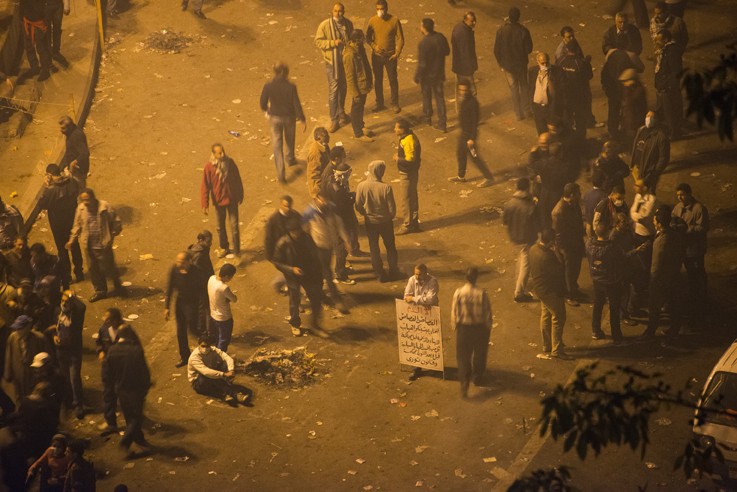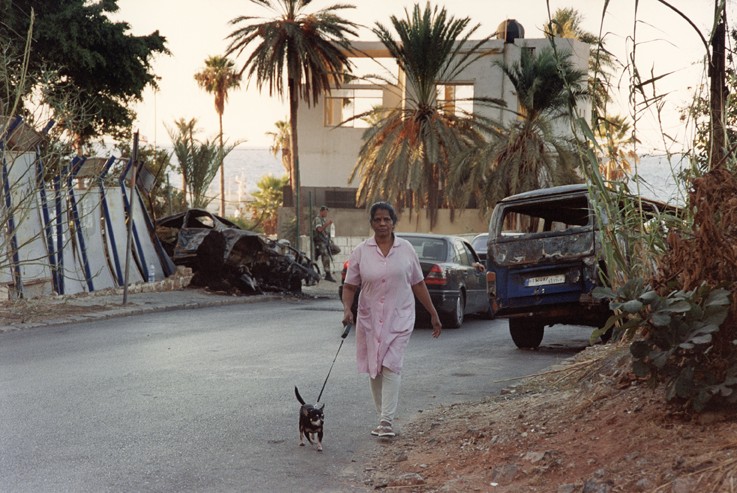Learning from the Lens
The Photography of Lidwien van de Ven
For the Dutch-born photographer Lidwien van de Ven, photography is a reciprocal process of give and take. The reason for travelling to another country is to learn from where you are, rather than going there to “take” a picture. As she says in the following interview, “I go to places where I want to witness what is happening.” She has no predetermined idea of what she will find, but instead searches for evidence that will aid in understanding the nature and the cause of the events that have occurred in any location.
Being present as a witness has traditionally been one of the claims made by photojournalists who go into coflict zones to capture images that purport to tell the truth about a situation. The argument of truth telling presents a problem for an artist who has no confidence in the photograph as a container of a singular message, or in the existence of a single message in the first place. In this sense, van de Ven’s work functions outside the frame of picture making that recognizes the idea of the decisive moment, and it explains her attraction towards images that are ambiguous, “that can be read in more than one way.” Her interest is less in what is immediately apparent in the photograph than in what is happening in the background, what she calls “the backdrop,” and in that space she finds “the newsworthy thing.” She is especially adept at this behind-the-scenes reconnaissance: in the almost incidental presence of a soldier who is watching over the site of a bomb attack in Beirut; in the figures who appear like apparitions to light fires as a way of producing heat and light in the collapsed city of Gaza; or in the young boy sitting in a door frame in Ramallah who hides his face for reasons that are undeclared and unavailable to us as viewers.

Lidwien van de Ven, Gaza, 12/11/2014 (Shu’jaiya), 2014, igital print on paper, 2.5 x 4.5 meters.
Van de Ven wants us to recognize that her images are layered. In her photograph called Cairo, 28/02/2014 (martyrs), you can see the operations of this necessary strategy of reading and rereading. The image shows a hoarding with the likenesses of men who had died fighting for democracy during the Arab Spring in 2011. These martyrs were resisting the same military regime that returned to power two years later. Their eyes have been blacked out. What on first read could be seen as an act of desecration of these heroes turns out to be the opposite: they were rendered sightless by a sympathizer who didn’t want them to see what had become of the country for which they had fought and died. What we see if we’re uninformed and not looking closely is evidence of hurried graffiti. What is actually there is an act of respect that takes the form of street art.

Cairo, 28/02/2014 (martyrs), 2014 digital print on paper, 2.5 x 3.75 meters.
Van de Ven’s explanation of her process is that “there is a lot to learn from bringing a camera into a situation, how it changes and influences your relationship to your surrounding.” The education is two-sided. As viewers we, too, learn from the pictures that come out of her camera-recorded situations. There is a false comfort gained in thinking that the political, moral and economic struggles the media brings to our attention are easily understandable. What the lens has taught van de Ven is that every lesson is contingent because every image opens up another question for which the photograph cannot provide the answer. She warns that accepting what she calls “fake, for-or-against solidarities” is to lose sight of the complex and layered reality of those places where she goes, and that our read should be equivalent to their complexity. For her, learning from the lens is demanding and ongoing, and it runs deep.
The following interview was conducted in the School of Art Gallery at the University of Manitoba on March 11, 2017. “Living On” was at the gallery from March 10 to April 28, 2017, and was curated by Dr. Shepherd Steiner. The exhibition was organized around a symposium of the same name in honour of the 50th anniversary of Mosaic, the interdisciplinary journal of literature and ideas.
Border Crossings: I want to get a sense of your early training. Did you start out wanting to be a photographer?
Lidwien van de Ven: I was trained in the Art Academy in the Netherlands, not particularly in photography, but I always worked with photography in the form of installation. The department was quite a special one, called Mixed Media, and it would allow art students to combine things—it could be sculpture with painting or photography with painting. We were free to choose how we wanted to make our work. It had a bigger emphasis on conceptual art and performance.
That is interesting because installation is one of the areas of contemporary art that has not been theorized. We don’t entirely know what installation is as an art form. The fact that there was a department where you could work within that framework is unusual.

Cairo, 25/01/2013 (Tahir Square), 2014 digital print on paper, 2.5 x 3.75 meters.
When I studied in the Netherlands, art schools were very discipline-oriented and strict. If you wanted to cross over, the teachers wouldn’t look at your other disciplines. This has now changed. But the education I received at AKI [Academie voor Kunst en Industrie, Enschede] was based on an approach that allowed each student to have their own individual approach. There was a room that was about eight by eight metres square and we were free to use it for presenting our work.
Did photography turn out to be the discipline that became the principal way you organized the work in the room?
Yes. I went to the art school to become a photographer, but at the same time I also wanted to be a journalist. However, it was clear within half a year which way I was going to go and it would be art. I worked with photography but I also would do painting and installation with sculpture. In my case it was indeed mixed media, but photography was always an important element. The other thing was that I almost immediately worked in a large scale in the form of installation.
Had you already established what a journalist would do and what an artist would do? The reason I ask is because one of the questions your work raises is determining what kind of photography we are looking at. Did you have a sense early on about what it was going to be or was that a developing process?
I started a long time ago. My work has since developed through several stages. From early on I also followed a parallel trajectory in philosophy. In my development there has always been one or more other disciplines alongside the art.
You have said that photography for you is a form of research. What did you mean by that?
There is a lot to learn from bringing a camera into a situation, how it changes and influences your relationship to your surroundings. What I meant by “photography as research” also relates to learning from your situation and presence rather than aiming only at the photographic picture. At times I will not even use my camera. I go to places where I want to witness what is happening. So there is quite a large investment in the work. I also take many photos that I may never consider working with, but I will always work with the experience of engaging with the situation.
Once you’ve taken photographs, do they become part of the research or are they a more final declaration of what the research has led to?
All the photos I take and look at are part of this ongoing research. I am conscious of the gap between where the photo came from and the image itself. However, it is important to realize that my work always consists of roughly two parts. One is an ongoing follow-up on particular developments in religion and politics. The other is working towards a presentation or installation. I usually build this up in layers. I mostly work with photos that have a certain ambiguity in themselves, that can be read in more than one way. I keep in mind how this can connect within the presentation and to the viewer.
But you go to loaded places, like the West Bank, Ramallah and Beirut. Do you go there because of their complicated history and politics?
I do. My interest since the end of the ’90s developed from taking politics and religion as a lead. Parallel to that was the global change our societies underwent; for instance, under the influence of the post-9/11 developments. From 2000 onwards I have also travelled to the Middle East. I felt this was necessary to understand what was happening there and not just to have a European-minded view of, say, Islam.

Beirut, 02/10/2004 (Marwan Hamadeh), 2009, digital print on paper, 2.1 x 3.15 meters.
Were you ahead of the curve on your recognition of how important it was going to become?
Things like xenophobia were already there at end of the ’90s, but it speeded up rapidly after 9/11. The wars in the Middle East changed the region dramatically. I think it was good that I started before 2001, if only because I witnessed the Middle East before the wars in Afghanistan, Iraq and in Syria. Photographing in Iran in 2000 was a special moment because up to 1997 it was closed for Westerners and, in particular, for journalists. As a result our views of Iran here in the West were very limited and stereotyped, focusing mostly on Khomeini, chadors and anti-USA sentiments. Since then many more images, photos, films and tourist impressions have come from Iran and have broadened our visual sense of the country.
…to continue reading the interview with Lidwien van de Ven, order a copy of Issue #142 here, or SUBSCRIBE today!

